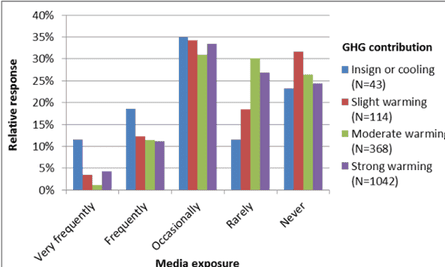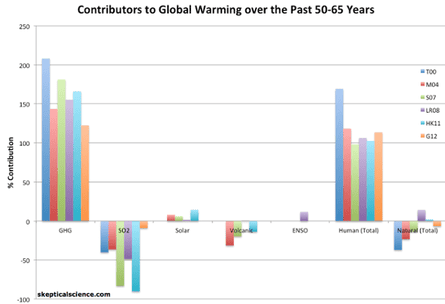A new study led by Bart Verheggen surveyed 1,868 scientists studying various aspects of climate change, asking them several questions mainly focused on what’s causing global warming. They survey also asked the respondents,
How frequently have you featured in the media regarding your views on climate change?
The answers to this question reflect whether the media is really fair and balanced on the subject of global warming. A truly balanced media would give equally proportional attention and coverage to climate scientists in the mainstream and on the fringes. For example, if 20% of contrarian climate scientists reported frequent media attention, a fair and balanced media would also give frequent coverage to 20% of mainstream climate scientists.
Instead, fringe contrarian climate scientists reported that they receive frequent media coverage twice as often as mainstream climate scientists.

Specifically, 30% of those few who said that greenhouse gases have caused an insignificant amount of global warming (or even cooling) reported frequent media coverage, compared to just 15% of climate scientists who said greenhouse gases have caused strong global warming.
This disproportionate media coverage of fringe climate contrarians is a problem known as “false balance,” and has plagued not only politically conservative media outlets, but also purportedly neutral news organizations like the BBC. It stems from journalists believing it’s “balanced” to give “both sides” of every issue equal coverage, even if one of those sides represents the views of a small fringe of qualified experts.
The practice is no different than giving equal time to evolutionary biologists and Creationists, or to medical doctors and those who claim smoking doesn’t cause cancer. This new study confirms that according to the scientists themselves, fringe climate contrarians who hold views well outside the mainstream are receiving disproportionate media coverage.
The survey also asked participants,
What fraction of global warming since the mid-20th century can be attributed to human-induced increases in atmospheric GHG [greenhouse gas] concentrations?
Among those who answered numerically and reported having published more than 10 peer-reviewed climate-related studies, 90% said that human greenhouse gas emissions have caused more than 50% of global warming since the 1950s. 70% said human greenhouse gases are responsible for more than 75% of that global warming, and 30% said they’re responsible for more than 100%.
The reason greenhouse gases can be (and probably are) responsible for more than 100% of the observed warming is that other factors (mainly human aerosol pollution) have caused cooling at the same time. For example, if greenhouse gases had caused 1°C of warming, aerosol pollution and other factors had caused 0.5°C cooling at the same time, there would be 0.5°C net warming with greenhouse gases responsible for 200% of it. Most papers studying this question have put the greenhouse gas contribution to global warming since mid-century at 120–200%.

The 90% consensus in this survey that human greenhouse gas emissions are the main contributor to the current global warming is somewhat of an underestimate. The authors of the study report,
...invitees tagged as ‘unconvinced’ (3% of invitees against 5% of respondents) ... were slightly overrepresented among the respondents
The authors also found evidence that some contrarians had inflated their number of self-reported peer-reviewed climate-related papers. However, they didn’t quantify this effect, so all we can say is that the expert consensus that humans are the main contributor to global warming is somewhere north of 90%.
This result is broadly consistent with the survey performed by Doran & Zimmerman in 2009, which found that 97% of climate scientists agreed that humans are causing significant global warming. However, the Verheggen survey included much more specific questions, for example asking climate scientists to quantify the human contribution, and had a much larger sample size of climate experts. The result is also similar to the 97% consensus found in surveys of climate experts’ public statements and peer-reviewed research.
This new paper also asked,
What is your estimate of equilibrium (Charney) climate sensitivity, i.e. the temperature response (degrees C) to a doubling of CO2?
The latest IPCC report put the climate sensitivity at between 1.5 and 4.5°C global surface warming in response to a doubling of atmospheric carbon dioxide. Most of the responses fell within that range, with about half putting the figure in the middle, between 2.5 and 3.5°C. About 25% put it on the low end of the IPCC range, between 1.5 and 2.5°C. The rest were equally divided between the value being larger than 3.5°C and smaller than 1.5°C.
Again, those who answered that climate sensitivity is below the accepted range reported the most frequent media exposure.
Overall we have yet another study finding an expert consensus of over 90% that humans are the main cause of the current global warming. Yet a recent public survey by Yale and George Mason Universities found that only 12% of Americans realize the consensus is above 90%. This “consensus gap” can largely be traced back to the media false balance identified in the Verheggen paper, with fringe climate contrarians receiving disproportionate media attention.

Comments (…)
Sign in or create your Guardian account to join the discussion